Improving Healthcare: Leadership Framework at St Thomas' Hospital
VerifiedAdded on 2023/06/07
|21
|8337
|489
Report
AI Summary
This report explores the leadership framework implemented at St. Thomas' Hospital in Central London to improve the quality of healthcare services. It discusses the notion of a leadership framework, evaluates the potential effects of a visionary leadership approach, and determines strategies to maximize its effectiveness. The report references various leadership styles, including transactional, democratic, and autocratic leadership, and emphasizes the importance of constructive criticism. A project plan outlines the scope, resources, communication strategies, and potential risks associated with implementing the framework, culminating in a Gantt chart for project management. The aim is to provide insights into how leadership can drive improvements in patient care and overall healthcare service delivery at St. Thomas' Hospital, with a focus on enhancing patient satisfaction, safety, and health outcomes.
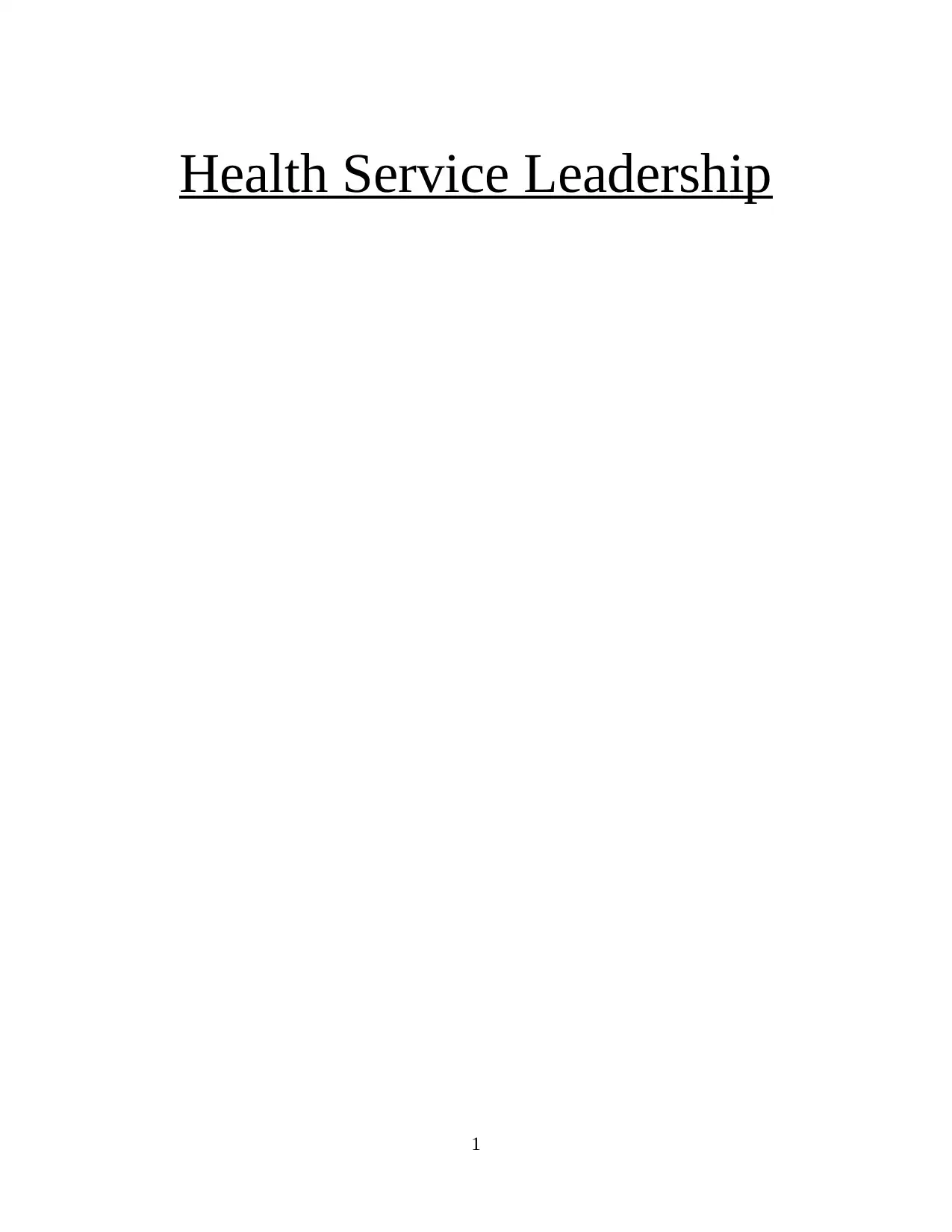
Health Service Leadership
1
1
Paraphrase This Document
Need a fresh take? Get an instant paraphrase of this document with our AI Paraphraser
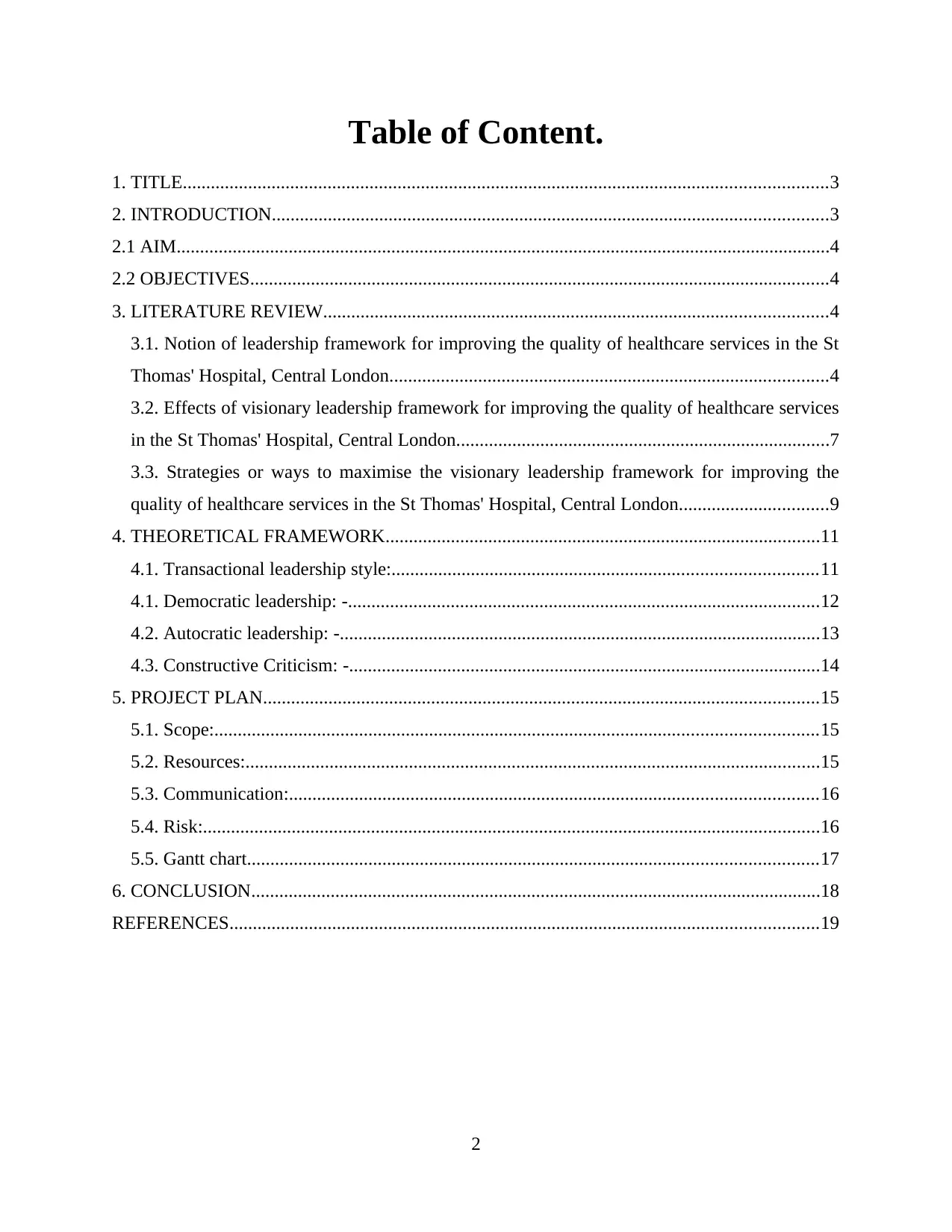
Table of Content.
1. TITLE..........................................................................................................................................3
2. INTRODUCTION.......................................................................................................................3
2.1 AIM............................................................................................................................................4
2.2 OBJECTIVES............................................................................................................................4
3. LITERATURE REVIEW............................................................................................................4
3.1. Notion of leadership framework for improving the quality of healthcare services in the St
Thomas' Hospital, Central London..............................................................................................4
3.2. Effects of visionary leadership framework for improving the quality of healthcare services
in the St Thomas' Hospital, Central London................................................................................7
3.3. Strategies or ways to maximise the visionary leadership framework for improving the
quality of healthcare services in the St Thomas' Hospital, Central London................................9
4. THEORETICAL FRAMEWORK.............................................................................................11
4.1. Transactional leadership style:...........................................................................................11
4.1. Democratic leadership: -.....................................................................................................12
4.2. Autocratic leadership: -.......................................................................................................13
4.3. Constructive Criticism: -.....................................................................................................14
5. PROJECT PLAN.......................................................................................................................15
5.1. Scope:.................................................................................................................................15
5.2. Resources:...........................................................................................................................15
5.3. Communication:.................................................................................................................16
5.4. Risk:....................................................................................................................................16
5.5. Gantt chart..........................................................................................................................17
6. CONCLUSION..........................................................................................................................18
REFERENCES..............................................................................................................................19
2
1. TITLE..........................................................................................................................................3
2. INTRODUCTION.......................................................................................................................3
2.1 AIM............................................................................................................................................4
2.2 OBJECTIVES............................................................................................................................4
3. LITERATURE REVIEW............................................................................................................4
3.1. Notion of leadership framework for improving the quality of healthcare services in the St
Thomas' Hospital, Central London..............................................................................................4
3.2. Effects of visionary leadership framework for improving the quality of healthcare services
in the St Thomas' Hospital, Central London................................................................................7
3.3. Strategies or ways to maximise the visionary leadership framework for improving the
quality of healthcare services in the St Thomas' Hospital, Central London................................9
4. THEORETICAL FRAMEWORK.............................................................................................11
4.1. Transactional leadership style:...........................................................................................11
4.1. Democratic leadership: -.....................................................................................................12
4.2. Autocratic leadership: -.......................................................................................................13
4.3. Constructive Criticism: -.....................................................................................................14
5. PROJECT PLAN.......................................................................................................................15
5.1. Scope:.................................................................................................................................15
5.2. Resources:...........................................................................................................................15
5.3. Communication:.................................................................................................................16
5.4. Risk:....................................................................................................................................16
5.5. Gantt chart..........................................................................................................................17
6. CONCLUSION..........................................................................................................................18
REFERENCES..............................................................................................................................19
2
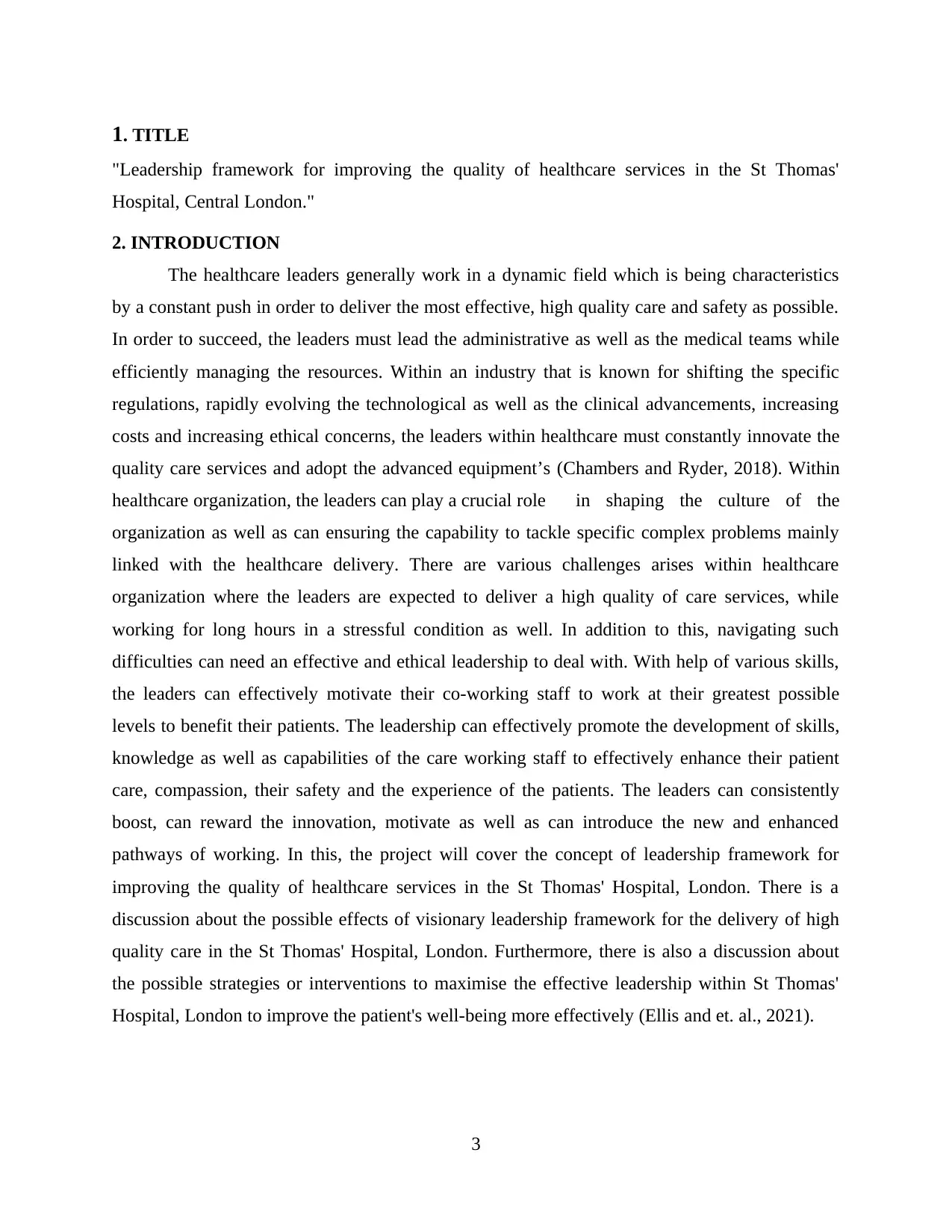
1. TITLE
"Leadership framework for improving the quality of healthcare services in the St Thomas'
Hospital, Central London."
2. INTRODUCTION
The healthcare leaders generally work in a dynamic field which is being characteristics
by a constant push in order to deliver the most effective, high quality care and safety as possible.
In order to succeed, the leaders must lead the administrative as well as the medical teams while
efficiently managing the resources. Within an industry that is known for shifting the specific
regulations, rapidly evolving the technological as well as the clinical advancements, increasing
costs and increasing ethical concerns, the leaders within healthcare must constantly innovate the
quality care services and adopt the advanced equipment’s (Chambers and Ryder, 2018). Within
healthcare organization, the leaders can play a crucial role in shaping the culture of the
organization as well as can ensuring the capability to tackle specific complex problems mainly
linked with the healthcare delivery. There are various challenges arises within healthcare
organization where the leaders are expected to deliver a high quality of care services, while
working for long hours in a stressful condition as well. In addition to this, navigating such
difficulties can need an effective and ethical leadership to deal with. With help of various skills,
the leaders can effectively motivate their co-working staff to work at their greatest possible
levels to benefit their patients. The leadership can effectively promote the development of skills,
knowledge as well as capabilities of the care working staff to effectively enhance their patient
care, compassion, their safety and the experience of the patients. The leaders can consistently
boost, can reward the innovation, motivate as well as can introduce the new and enhanced
pathways of working. In this, the project will cover the concept of leadership framework for
improving the quality of healthcare services in the St Thomas' Hospital, London. There is a
discussion about the possible effects of visionary leadership framework for the delivery of high
quality care in the St Thomas' Hospital, London. Furthermore, there is also a discussion about
the possible strategies or interventions to maximise the effective leadership within St Thomas'
Hospital, London to improve the patient's well-being more effectively (Ellis and et. al., 2021).
3
"Leadership framework for improving the quality of healthcare services in the St Thomas'
Hospital, Central London."
2. INTRODUCTION
The healthcare leaders generally work in a dynamic field which is being characteristics
by a constant push in order to deliver the most effective, high quality care and safety as possible.
In order to succeed, the leaders must lead the administrative as well as the medical teams while
efficiently managing the resources. Within an industry that is known for shifting the specific
regulations, rapidly evolving the technological as well as the clinical advancements, increasing
costs and increasing ethical concerns, the leaders within healthcare must constantly innovate the
quality care services and adopt the advanced equipment’s (Chambers and Ryder, 2018). Within
healthcare organization, the leaders can play a crucial role in shaping the culture of the
organization as well as can ensuring the capability to tackle specific complex problems mainly
linked with the healthcare delivery. There are various challenges arises within healthcare
organization where the leaders are expected to deliver a high quality of care services, while
working for long hours in a stressful condition as well. In addition to this, navigating such
difficulties can need an effective and ethical leadership to deal with. With help of various skills,
the leaders can effectively motivate their co-working staff to work at their greatest possible
levels to benefit their patients. The leadership can effectively promote the development of skills,
knowledge as well as capabilities of the care working staff to effectively enhance their patient
care, compassion, their safety and the experience of the patients. The leaders can consistently
boost, can reward the innovation, motivate as well as can introduce the new and enhanced
pathways of working. In this, the project will cover the concept of leadership framework for
improving the quality of healthcare services in the St Thomas' Hospital, London. There is a
discussion about the possible effects of visionary leadership framework for the delivery of high
quality care in the St Thomas' Hospital, London. Furthermore, there is also a discussion about
the possible strategies or interventions to maximise the effective leadership within St Thomas'
Hospital, London to improve the patient's well-being more effectively (Ellis and et. al., 2021).
3
⊘ This is a preview!⊘
Do you want full access?
Subscribe today to unlock all pages.

Trusted by 1+ million students worldwide
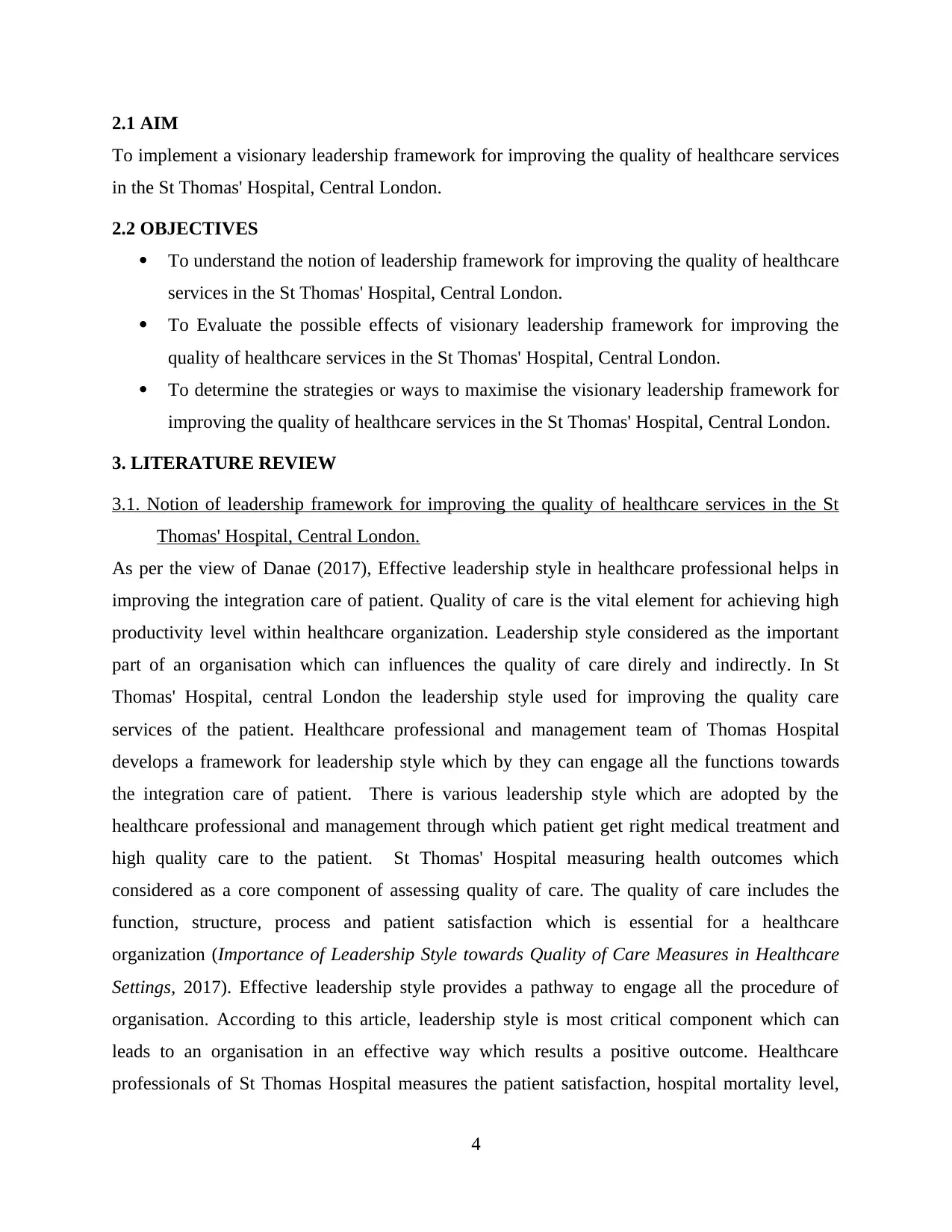
2.1 AIM
To implement a visionary leadership framework for improving the quality of healthcare services
in the St Thomas' Hospital, Central London.
2.2 OBJECTIVES
To understand the notion of leadership framework for improving the quality of healthcare
services in the St Thomas' Hospital, Central London.
To Evaluate the possible effects of visionary leadership framework for improving the
quality of healthcare services in the St Thomas' Hospital, Central London.
To determine the strategies or ways to maximise the visionary leadership framework for
improving the quality of healthcare services in the St Thomas' Hospital, Central London.
3. LITERATURE REVIEW
3.1. Notion of leadership framework for improving the quality of healthcare services in the St
Thomas' Hospital, Central London.
As per the view of Danae (2017), Effective leadership style in healthcare professional helps in
improving the integration care of patient. Quality of care is the vital element for achieving high
productivity level within healthcare organization. Leadership style considered as the important
part of an organisation which can influences the quality of care direly and indirectly. In St
Thomas' Hospital, central London the leadership style used for improving the quality care
services of the patient. Healthcare professional and management team of Thomas Hospital
develops a framework for leadership style which by they can engage all the functions towards
the integration care of patient. There is various leadership style which are adopted by the
healthcare professional and management through which patient get right medical treatment and
high quality care to the patient. St Thomas' Hospital measuring health outcomes which
considered as a core component of assessing quality of care. The quality of care includes the
function, structure, process and patient satisfaction which is essential for a healthcare
organization (Importance of Leadership Style towards Quality of Care Measures in Healthcare
Settings, 2017). Effective leadership style provides a pathway to engage all the procedure of
organisation. According to this article, leadership style is most critical component which can
leads to an organisation in an effective way which results a positive outcome. Healthcare
professionals of St Thomas Hospital measures the patient satisfaction, hospital mortality level,
4
To implement a visionary leadership framework for improving the quality of healthcare services
in the St Thomas' Hospital, Central London.
2.2 OBJECTIVES
To understand the notion of leadership framework for improving the quality of healthcare
services in the St Thomas' Hospital, Central London.
To Evaluate the possible effects of visionary leadership framework for improving the
quality of healthcare services in the St Thomas' Hospital, Central London.
To determine the strategies or ways to maximise the visionary leadership framework for
improving the quality of healthcare services in the St Thomas' Hospital, Central London.
3. LITERATURE REVIEW
3.1. Notion of leadership framework for improving the quality of healthcare services in the St
Thomas' Hospital, Central London.
As per the view of Danae (2017), Effective leadership style in healthcare professional helps in
improving the integration care of patient. Quality of care is the vital element for achieving high
productivity level within healthcare organization. Leadership style considered as the important
part of an organisation which can influences the quality of care direly and indirectly. In St
Thomas' Hospital, central London the leadership style used for improving the quality care
services of the patient. Healthcare professional and management team of Thomas Hospital
develops a framework for leadership style which by they can engage all the functions towards
the integration care of patient. There is various leadership style which are adopted by the
healthcare professional and management through which patient get right medical treatment and
high quality care to the patient. St Thomas' Hospital measuring health outcomes which
considered as a core component of assessing quality of care. The quality of care includes the
function, structure, process and patient satisfaction which is essential for a healthcare
organization (Importance of Leadership Style towards Quality of Care Measures in Healthcare
Settings, 2017). Effective leadership style provides a pathway to engage all the procedure of
organisation. According to this article, leadership style is most critical component which can
leads to an organisation in an effective way which results a positive outcome. Healthcare
professionals of St Thomas Hospital measures the patient satisfaction, hospital mortality level,
4
Paraphrase This Document
Need a fresh take? Get an instant paraphrase of this document with our AI Paraphraser
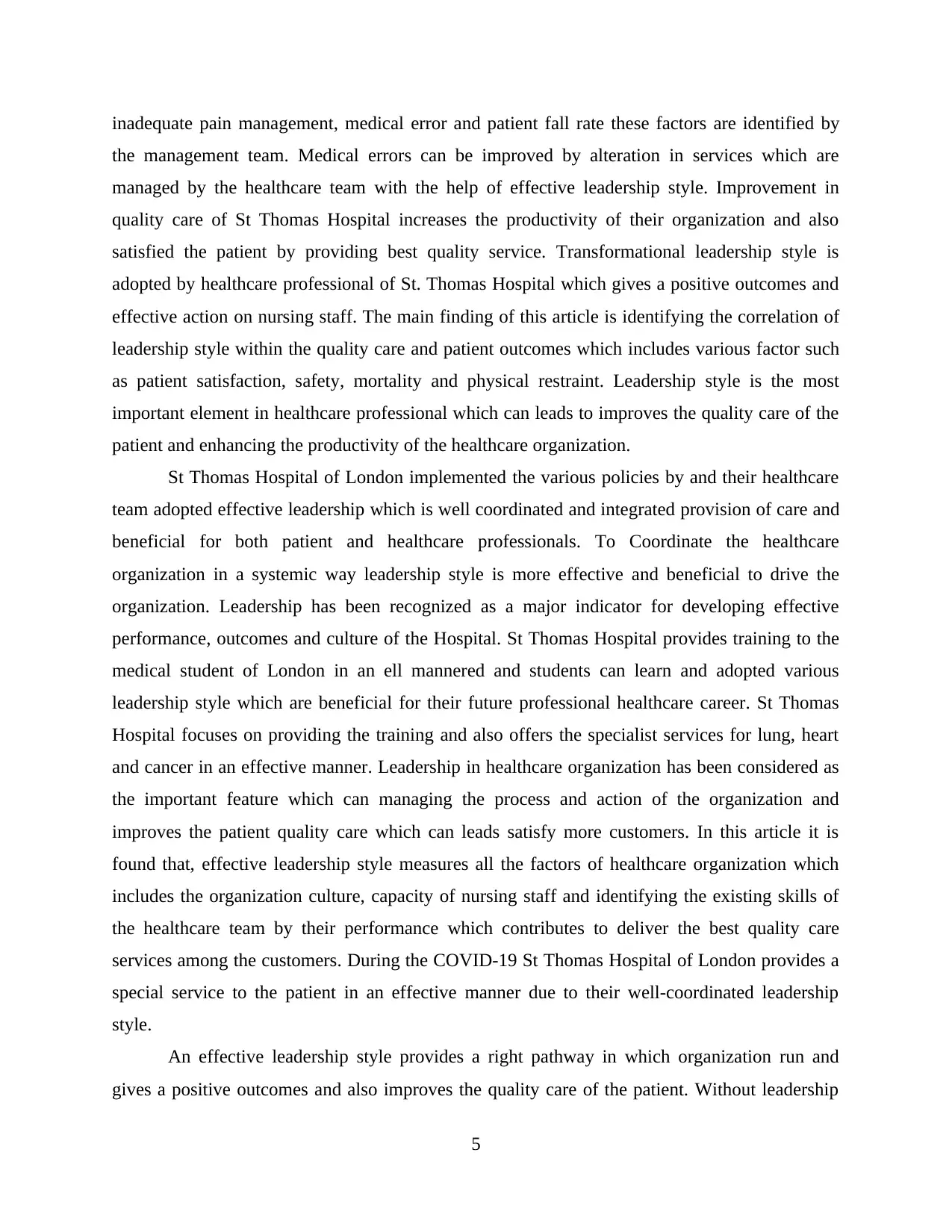
inadequate pain management, medical error and patient fall rate these factors are identified by
the management team. Medical errors can be improved by alteration in services which are
managed by the healthcare team with the help of effective leadership style. Improvement in
quality care of St Thomas Hospital increases the productivity of their organization and also
satisfied the patient by providing best quality service. Transformational leadership style is
adopted by healthcare professional of St. Thomas Hospital which gives a positive outcomes and
effective action on nursing staff. The main finding of this article is identifying the correlation of
leadership style within the quality care and patient outcomes which includes various factor such
as patient satisfaction, safety, mortality and physical restraint. Leadership style is the most
important element in healthcare professional which can leads to improves the quality care of the
patient and enhancing the productivity of the healthcare organization.
St Thomas Hospital of London implemented the various policies by and their healthcare
team adopted effective leadership which is well coordinated and integrated provision of care and
beneficial for both patient and healthcare professionals. To Coordinate the healthcare
organization in a systemic way leadership style is more effective and beneficial to drive the
organization. Leadership has been recognized as a major indicator for developing effective
performance, outcomes and culture of the Hospital. St Thomas Hospital provides training to the
medical student of London in an ell mannered and students can learn and adopted various
leadership style which are beneficial for their future professional healthcare career. St Thomas
Hospital focuses on providing the training and also offers the specialist services for lung, heart
and cancer in an effective manner. Leadership in healthcare organization has been considered as
the important feature which can managing the process and action of the organization and
improves the patient quality care which can leads satisfy more customers. In this article it is
found that, effective leadership style measures all the factors of healthcare organization which
includes the organization culture, capacity of nursing staff and identifying the existing skills of
the healthcare team by their performance which contributes to deliver the best quality care
services among the customers. During the COVID-19 St Thomas Hospital of London provides a
special service to the patient in an effective manner due to their well-coordinated leadership
style.
An effective leadership style provides a right pathway in which organization run and
gives a positive outcomes and also improves the quality care of the patient. Without leadership
5
the management team. Medical errors can be improved by alteration in services which are
managed by the healthcare team with the help of effective leadership style. Improvement in
quality care of St Thomas Hospital increases the productivity of their organization and also
satisfied the patient by providing best quality service. Transformational leadership style is
adopted by healthcare professional of St. Thomas Hospital which gives a positive outcomes and
effective action on nursing staff. The main finding of this article is identifying the correlation of
leadership style within the quality care and patient outcomes which includes various factor such
as patient satisfaction, safety, mortality and physical restraint. Leadership style is the most
important element in healthcare professional which can leads to improves the quality care of the
patient and enhancing the productivity of the healthcare organization.
St Thomas Hospital of London implemented the various policies by and their healthcare
team adopted effective leadership which is well coordinated and integrated provision of care and
beneficial for both patient and healthcare professionals. To Coordinate the healthcare
organization in a systemic way leadership style is more effective and beneficial to drive the
organization. Leadership has been recognized as a major indicator for developing effective
performance, outcomes and culture of the Hospital. St Thomas Hospital provides training to the
medical student of London in an ell mannered and students can learn and adopted various
leadership style which are beneficial for their future professional healthcare career. St Thomas
Hospital focuses on providing the training and also offers the specialist services for lung, heart
and cancer in an effective manner. Leadership in healthcare organization has been considered as
the important feature which can managing the process and action of the organization and
improves the patient quality care which can leads satisfy more customers. In this article it is
found that, effective leadership style measures all the factors of healthcare organization which
includes the organization culture, capacity of nursing staff and identifying the existing skills of
the healthcare team by their performance which contributes to deliver the best quality care
services among the customers. During the COVID-19 St Thomas Hospital of London provides a
special service to the patient in an effective manner due to their well-coordinated leadership
style.
An effective leadership style provides a right pathway in which organization run and
gives a positive outcomes and also improves the quality care of the patient. Without leadership
5
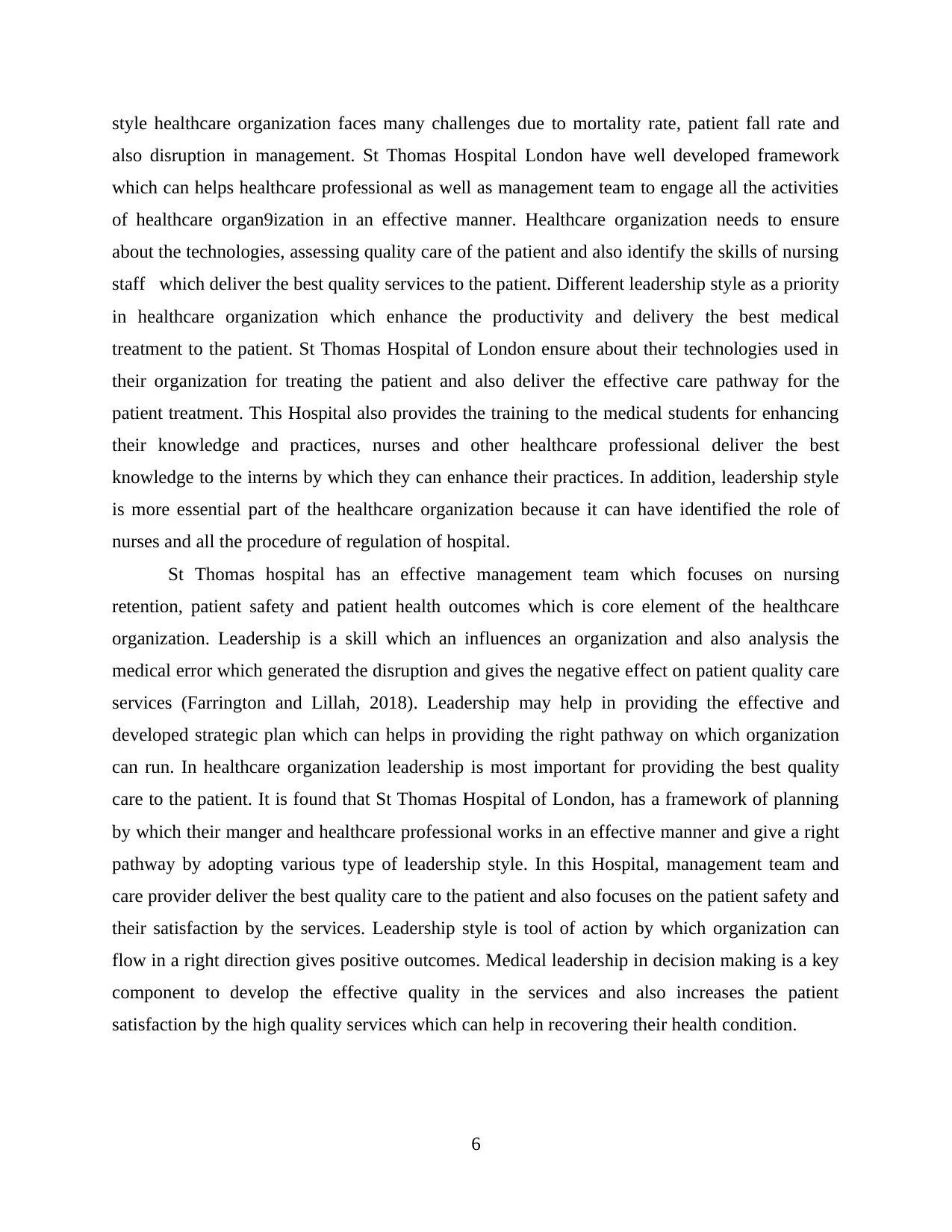
style healthcare organization faces many challenges due to mortality rate, patient fall rate and
also disruption in management. St Thomas Hospital London have well developed framework
which can helps healthcare professional as well as management team to engage all the activities
of healthcare organ9ization in an effective manner. Healthcare organization needs to ensure
about the technologies, assessing quality care of the patient and also identify the skills of nursing
staff which deliver the best quality services to the patient. Different leadership style as a priority
in healthcare organization which enhance the productivity and delivery the best medical
treatment to the patient. St Thomas Hospital of London ensure about their technologies used in
their organization for treating the patient and also deliver the effective care pathway for the
patient treatment. This Hospital also provides the training to the medical students for enhancing
their knowledge and practices, nurses and other healthcare professional deliver the best
knowledge to the interns by which they can enhance their practices. In addition, leadership style
is more essential part of the healthcare organization because it can have identified the role of
nurses and all the procedure of regulation of hospital.
St Thomas hospital has an effective management team which focuses on nursing
retention, patient safety and patient health outcomes which is core element of the healthcare
organization. Leadership is a skill which an influences an organization and also analysis the
medical error which generated the disruption and gives the negative effect on patient quality care
services (Farrington and Lillah, 2018). Leadership may help in providing the effective and
developed strategic plan which can helps in providing the right pathway on which organization
can run. In healthcare organization leadership is most important for providing the best quality
care to the patient. It is found that St Thomas Hospital of London, has a framework of planning
by which their manger and healthcare professional works in an effective manner and give a right
pathway by adopting various type of leadership style. In this Hospital, management team and
care provider deliver the best quality care to the patient and also focuses on the patient safety and
their satisfaction by the services. Leadership style is tool of action by which organization can
flow in a right direction gives positive outcomes. Medical leadership in decision making is a key
component to develop the effective quality in the services and also increases the patient
satisfaction by the high quality services which can help in recovering their health condition.
6
also disruption in management. St Thomas Hospital London have well developed framework
which can helps healthcare professional as well as management team to engage all the activities
of healthcare organ9ization in an effective manner. Healthcare organization needs to ensure
about the technologies, assessing quality care of the patient and also identify the skills of nursing
staff which deliver the best quality services to the patient. Different leadership style as a priority
in healthcare organization which enhance the productivity and delivery the best medical
treatment to the patient. St Thomas Hospital of London ensure about their technologies used in
their organization for treating the patient and also deliver the effective care pathway for the
patient treatment. This Hospital also provides the training to the medical students for enhancing
their knowledge and practices, nurses and other healthcare professional deliver the best
knowledge to the interns by which they can enhance their practices. In addition, leadership style
is more essential part of the healthcare organization because it can have identified the role of
nurses and all the procedure of regulation of hospital.
St Thomas hospital has an effective management team which focuses on nursing
retention, patient safety and patient health outcomes which is core element of the healthcare
organization. Leadership is a skill which an influences an organization and also analysis the
medical error which generated the disruption and gives the negative effect on patient quality care
services (Farrington and Lillah, 2018). Leadership may help in providing the effective and
developed strategic plan which can helps in providing the right pathway on which organization
can run. In healthcare organization leadership is most important for providing the best quality
care to the patient. It is found that St Thomas Hospital of London, has a framework of planning
by which their manger and healthcare professional works in an effective manner and give a right
pathway by adopting various type of leadership style. In this Hospital, management team and
care provider deliver the best quality care to the patient and also focuses on the patient safety and
their satisfaction by the services. Leadership style is tool of action by which organization can
flow in a right direction gives positive outcomes. Medical leadership in decision making is a key
component to develop the effective quality in the services and also increases the patient
satisfaction by the high quality services which can help in recovering their health condition.
6
⊘ This is a preview!⊘
Do you want full access?
Subscribe today to unlock all pages.

Trusted by 1+ million students worldwide
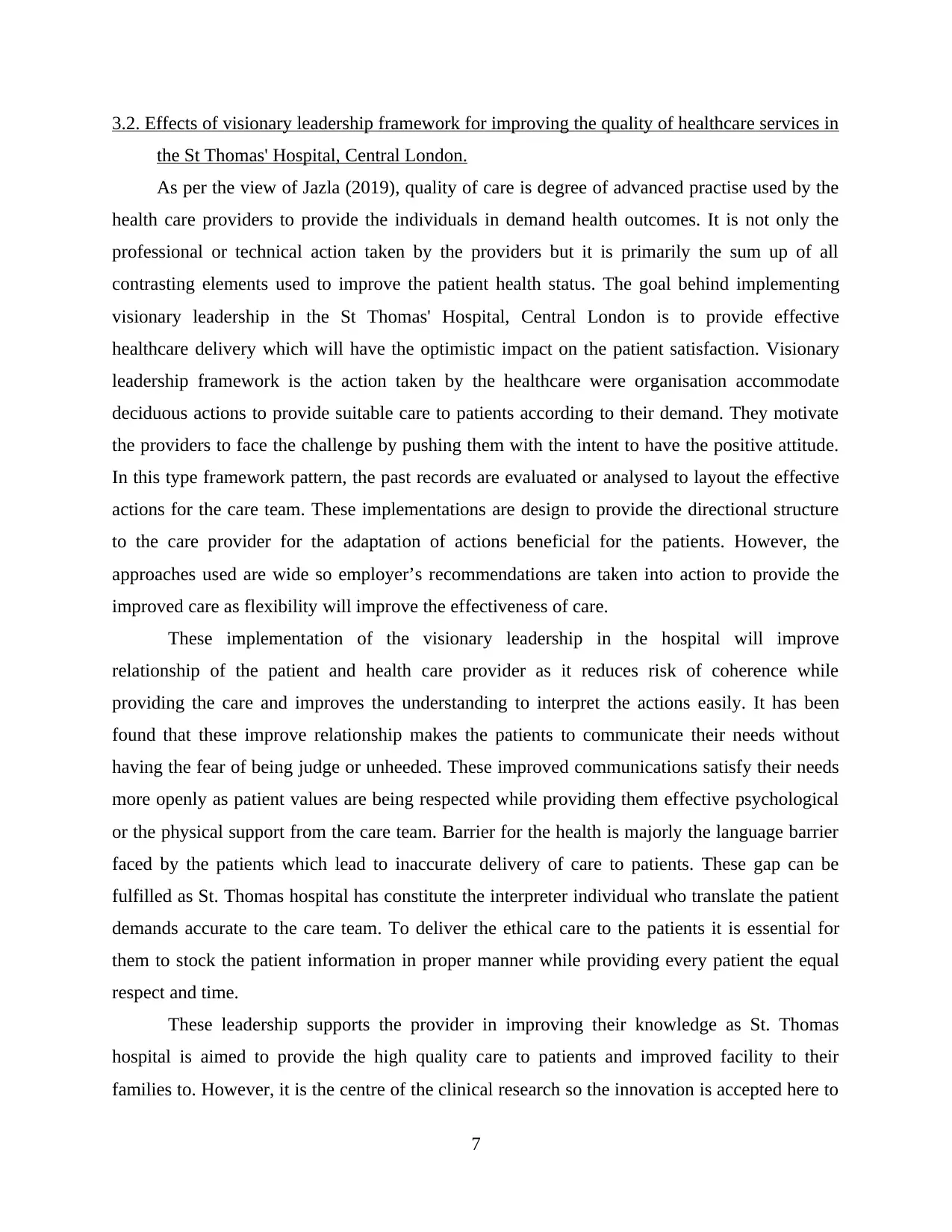
3.2. Effects of visionary leadership framework for improving the quality of healthcare services in
the St Thomas' Hospital, Central London.
As per the view of Jazla (2019), quality of care is degree of advanced practise used by the
health care providers to provide the individuals in demand health outcomes. It is not only the
professional or technical action taken by the providers but it is primarily the sum up of all
contrasting elements used to improve the patient health status. The goal behind implementing
visionary leadership in the St Thomas' Hospital, Central London is to provide effective
healthcare delivery which will have the optimistic impact on the patient satisfaction. Visionary
leadership framework is the action taken by the healthcare were organisation accommodate
deciduous actions to provide suitable care to patients according to their demand. They motivate
the providers to face the challenge by pushing them with the intent to have the positive attitude.
In this type framework pattern, the past records are evaluated or analysed to layout the effective
actions for the care team. These implementations are design to provide the directional structure
to the care provider for the adaptation of actions beneficial for the patients. However, the
approaches used are wide so employer’s recommendations are taken into action to provide the
improved care as flexibility will improve the effectiveness of care.
These implementation of the visionary leadership in the hospital will improve
relationship of the patient and health care provider as it reduces risk of coherence while
providing the care and improves the understanding to interpret the actions easily. It has been
found that these improve relationship makes the patients to communicate their needs without
having the fear of being judge or unheeded. These improved communications satisfy their needs
more openly as patient values are being respected while providing them effective psychological
or the physical support from the care team. Barrier for the health is majorly the language barrier
faced by the patients which lead to inaccurate delivery of care to patients. These gap can be
fulfilled as St. Thomas hospital has constitute the interpreter individual who translate the patient
demands accurate to the care team. To deliver the ethical care to the patients it is essential for
them to stock the patient information in proper manner while providing every patient the equal
respect and time.
These leadership supports the provider in improving their knowledge as St. Thomas
hospital is aimed to provide the high quality care to patients and improved facility to their
families to. However, it is the centre of the clinical research so the innovation is accepted here to
7
the St Thomas' Hospital, Central London.
As per the view of Jazla (2019), quality of care is degree of advanced practise used by the
health care providers to provide the individuals in demand health outcomes. It is not only the
professional or technical action taken by the providers but it is primarily the sum up of all
contrasting elements used to improve the patient health status. The goal behind implementing
visionary leadership in the St Thomas' Hospital, Central London is to provide effective
healthcare delivery which will have the optimistic impact on the patient satisfaction. Visionary
leadership framework is the action taken by the healthcare were organisation accommodate
deciduous actions to provide suitable care to patients according to their demand. They motivate
the providers to face the challenge by pushing them with the intent to have the positive attitude.
In this type framework pattern, the past records are evaluated or analysed to layout the effective
actions for the care team. These implementations are design to provide the directional structure
to the care provider for the adaptation of actions beneficial for the patients. However, the
approaches used are wide so employer’s recommendations are taken into action to provide the
improved care as flexibility will improve the effectiveness of care.
These implementation of the visionary leadership in the hospital will improve
relationship of the patient and health care provider as it reduces risk of coherence while
providing the care and improves the understanding to interpret the actions easily. It has been
found that these improve relationship makes the patients to communicate their needs without
having the fear of being judge or unheeded. These improved communications satisfy their needs
more openly as patient values are being respected while providing them effective psychological
or the physical support from the care team. Barrier for the health is majorly the language barrier
faced by the patients which lead to inaccurate delivery of care to patients. These gap can be
fulfilled as St. Thomas hospital has constitute the interpreter individual who translate the patient
demands accurate to the care team. To deliver the ethical care to the patients it is essential for
them to stock the patient information in proper manner while providing every patient the equal
respect and time.
These leadership supports the provider in improving their knowledge as St. Thomas
hospital is aimed to provide the high quality care to patients and improved facility to their
families to. However, it is the centre of the clinical research so the innovation is accepted here to
7
Paraphrase This Document
Need a fresh take? Get an instant paraphrase of this document with our AI Paraphraser
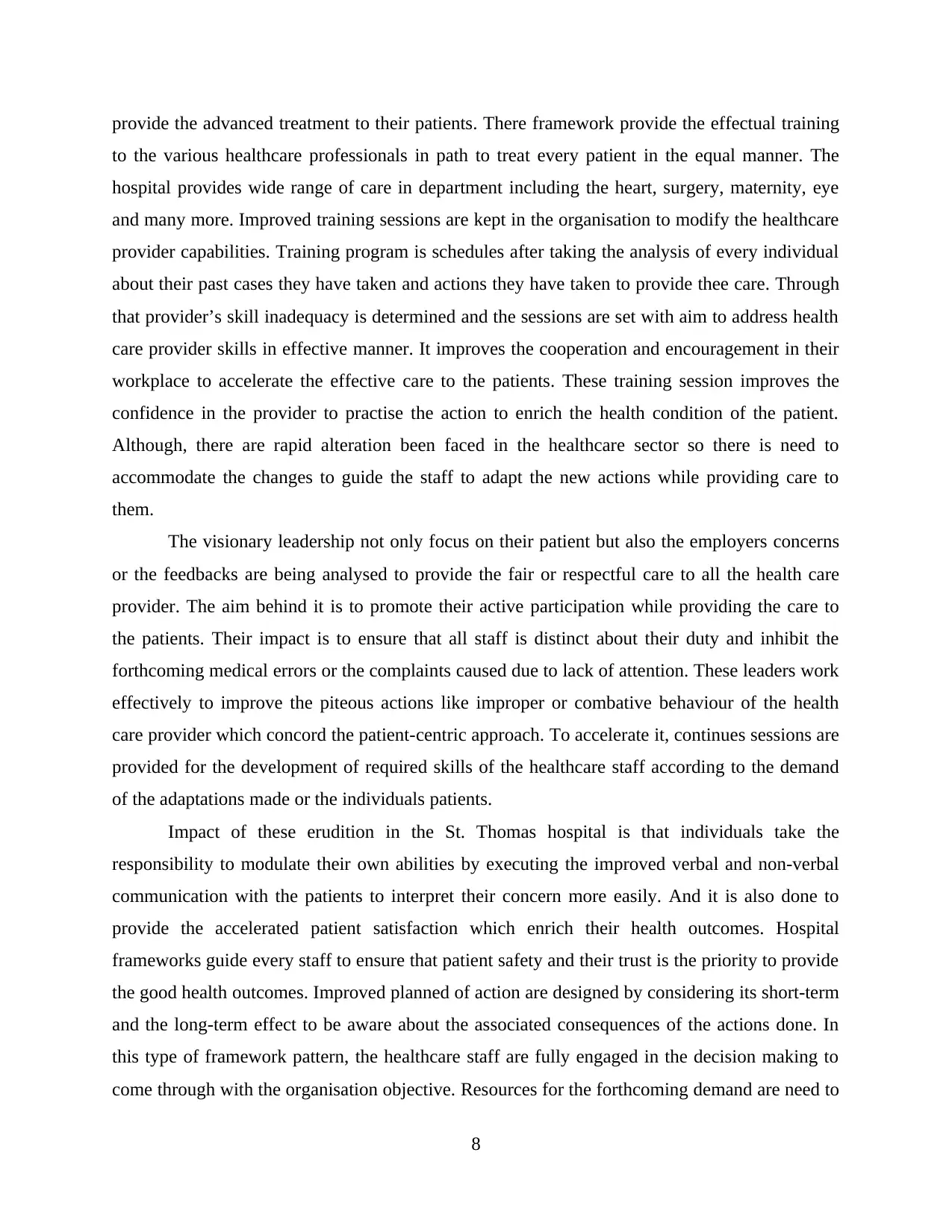
provide the advanced treatment to their patients. There framework provide the effectual training
to the various healthcare professionals in path to treat every patient in the equal manner. The
hospital provides wide range of care in department including the heart, surgery, maternity, eye
and many more. Improved training sessions are kept in the organisation to modify the healthcare
provider capabilities. Training program is schedules after taking the analysis of every individual
about their past cases they have taken and actions they have taken to provide thee care. Through
that provider’s skill inadequacy is determined and the sessions are set with aim to address health
care provider skills in effective manner. It improves the cooperation and encouragement in their
workplace to accelerate the effective care to the patients. These training session improves the
confidence in the provider to practise the action to enrich the health condition of the patient.
Although, there are rapid alteration been faced in the healthcare sector so there is need to
accommodate the changes to guide the staff to adapt the new actions while providing care to
them.
The visionary leadership not only focus on their patient but also the employers concerns
or the feedbacks are being analysed to provide the fair or respectful care to all the health care
provider. The aim behind it is to promote their active participation while providing the care to
the patients. Their impact is to ensure that all staff is distinct about their duty and inhibit the
forthcoming medical errors or the complaints caused due to lack of attention. These leaders work
effectively to improve the piteous actions like improper or combative behaviour of the health
care provider which concord the patient-centric approach. To accelerate it, continues sessions are
provided for the development of required skills of the healthcare staff according to the demand
of the adaptations made or the individuals patients.
Impact of these erudition in the St. Thomas hospital is that individuals take the
responsibility to modulate their own abilities by executing the improved verbal and non-verbal
communication with the patients to interpret their concern more easily. And it is also done to
provide the accelerated patient satisfaction which enrich their health outcomes. Hospital
frameworks guide every staff to ensure that patient safety and their trust is the priority to provide
the good health outcomes. Improved planned of action are designed by considering its short-term
and the long-term effect to be aware about the associated consequences of the actions done. In
this type of framework pattern, the healthcare staff are fully engaged in the decision making to
come through with the organisation objective. Resources for the forthcoming demand are need to
8
to the various healthcare professionals in path to treat every patient in the equal manner. The
hospital provides wide range of care in department including the heart, surgery, maternity, eye
and many more. Improved training sessions are kept in the organisation to modify the healthcare
provider capabilities. Training program is schedules after taking the analysis of every individual
about their past cases they have taken and actions they have taken to provide thee care. Through
that provider’s skill inadequacy is determined and the sessions are set with aim to address health
care provider skills in effective manner. It improves the cooperation and encouragement in their
workplace to accelerate the effective care to the patients. These training session improves the
confidence in the provider to practise the action to enrich the health condition of the patient.
Although, there are rapid alteration been faced in the healthcare sector so there is need to
accommodate the changes to guide the staff to adapt the new actions while providing care to
them.
The visionary leadership not only focus on their patient but also the employers concerns
or the feedbacks are being analysed to provide the fair or respectful care to all the health care
provider. The aim behind it is to promote their active participation while providing the care to
the patients. Their impact is to ensure that all staff is distinct about their duty and inhibit the
forthcoming medical errors or the complaints caused due to lack of attention. These leaders work
effectively to improve the piteous actions like improper or combative behaviour of the health
care provider which concord the patient-centric approach. To accelerate it, continues sessions are
provided for the development of required skills of the healthcare staff according to the demand
of the adaptations made or the individuals patients.
Impact of these erudition in the St. Thomas hospital is that individuals take the
responsibility to modulate their own abilities by executing the improved verbal and non-verbal
communication with the patients to interpret their concern more easily. And it is also done to
provide the accelerated patient satisfaction which enrich their health outcomes. Hospital
frameworks guide every staff to ensure that patient safety and their trust is the priority to provide
the good health outcomes. Improved planned of action are designed by considering its short-term
and the long-term effect to be aware about the associated consequences of the actions done. In
this type of framework pattern, the healthcare staff are fully engaged in the decision making to
come through with the organisation objective. Resources for the forthcoming demand are need to
8
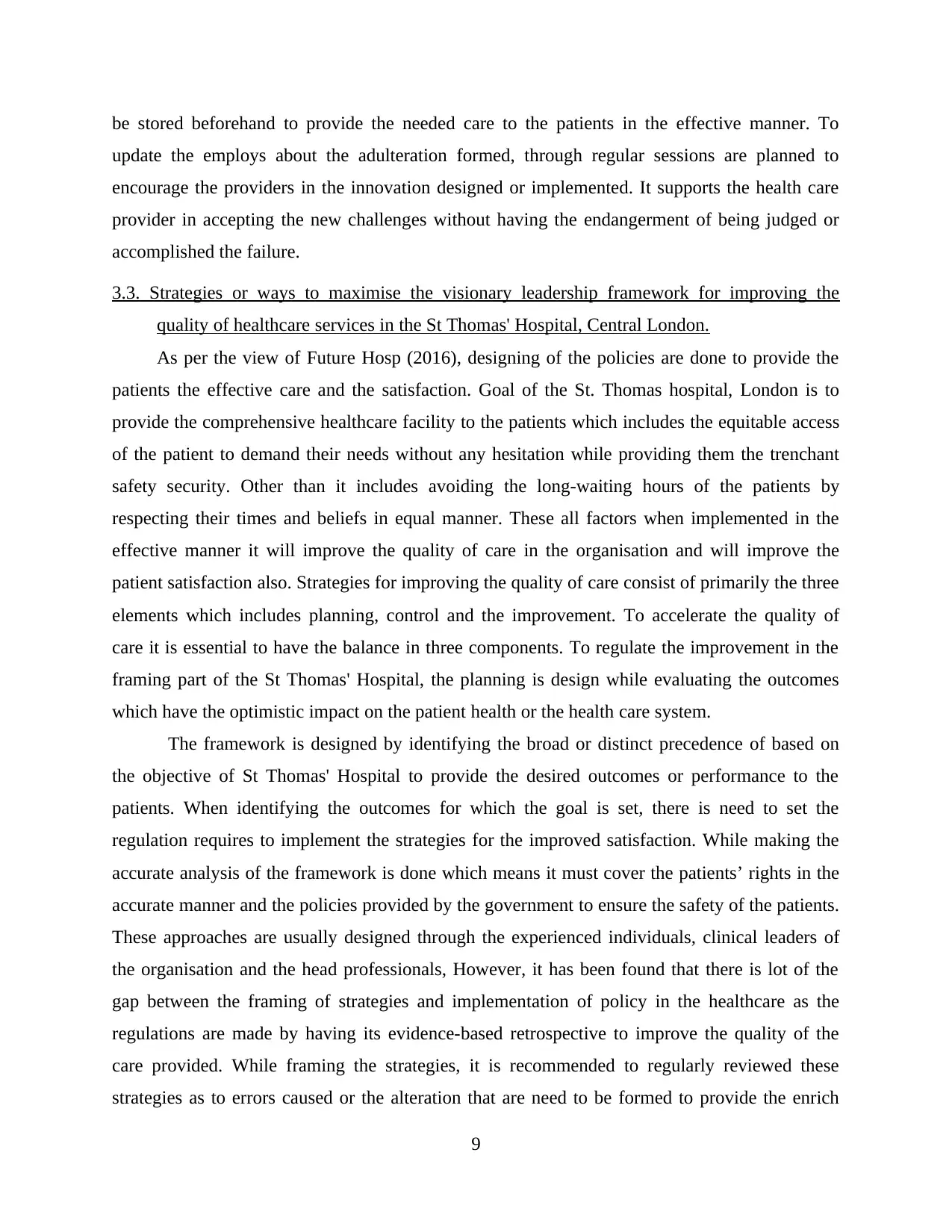
be stored beforehand to provide the needed care to the patients in the effective manner. To
update the employs about the adulteration formed, through regular sessions are planned to
encourage the providers in the innovation designed or implemented. It supports the health care
provider in accepting the new challenges without having the endangerment of being judged or
accomplished the failure.
3.3. Strategies or ways to maximise the visionary leadership framework for improving the
quality of healthcare services in the St Thomas' Hospital, Central London.
As per the view of Future Hosp (2016), designing of the policies are done to provide the
patients the effective care and the satisfaction. Goal of the St. Thomas hospital, London is to
provide the comprehensive healthcare facility to the patients which includes the equitable access
of the patient to demand their needs without any hesitation while providing them the trenchant
safety security. Other than it includes avoiding the long-waiting hours of the patients by
respecting their times and beliefs in equal manner. These all factors when implemented in the
effective manner it will improve the quality of care in the organisation and will improve the
patient satisfaction also. Strategies for improving the quality of care consist of primarily the three
elements which includes planning, control and the improvement. To accelerate the quality of
care it is essential to have the balance in three components. To regulate the improvement in the
framing part of the St Thomas' Hospital, the planning is design while evaluating the outcomes
which have the optimistic impact on the patient health or the health care system.
The framework is designed by identifying the broad or distinct precedence of based on
the objective of St Thomas' Hospital to provide the desired outcomes or performance to the
patients. When identifying the outcomes for which the goal is set, there is need to set the
regulation requires to implement the strategies for the improved satisfaction. While making the
accurate analysis of the framework is done which means it must cover the patients’ rights in the
accurate manner and the policies provided by the government to ensure the safety of the patients.
These approaches are usually designed through the experienced individuals, clinical leaders of
the organisation and the head professionals, However, it has been found that there is lot of the
gap between the framing of strategies and implementation of policy in the healthcare as the
regulations are made by having its evidence-based retrospective to improve the quality of the
care provided. While framing the strategies, it is recommended to regularly reviewed these
strategies as to errors caused or the alteration that are need to be formed to provide the enrich
9
update the employs about the adulteration formed, through regular sessions are planned to
encourage the providers in the innovation designed or implemented. It supports the health care
provider in accepting the new challenges without having the endangerment of being judged or
accomplished the failure.
3.3. Strategies or ways to maximise the visionary leadership framework for improving the
quality of healthcare services in the St Thomas' Hospital, Central London.
As per the view of Future Hosp (2016), designing of the policies are done to provide the
patients the effective care and the satisfaction. Goal of the St. Thomas hospital, London is to
provide the comprehensive healthcare facility to the patients which includes the equitable access
of the patient to demand their needs without any hesitation while providing them the trenchant
safety security. Other than it includes avoiding the long-waiting hours of the patients by
respecting their times and beliefs in equal manner. These all factors when implemented in the
effective manner it will improve the quality of care in the organisation and will improve the
patient satisfaction also. Strategies for improving the quality of care consist of primarily the three
elements which includes planning, control and the improvement. To accelerate the quality of
care it is essential to have the balance in three components. To regulate the improvement in the
framing part of the St Thomas' Hospital, the planning is design while evaluating the outcomes
which have the optimistic impact on the patient health or the health care system.
The framework is designed by identifying the broad or distinct precedence of based on
the objective of St Thomas' Hospital to provide the desired outcomes or performance to the
patients. When identifying the outcomes for which the goal is set, there is need to set the
regulation requires to implement the strategies for the improved satisfaction. While making the
accurate analysis of the framework is done which means it must cover the patients’ rights in the
accurate manner and the policies provided by the government to ensure the safety of the patients.
These approaches are usually designed through the experienced individuals, clinical leaders of
the organisation and the head professionals, However, it has been found that there is lot of the
gap between the framing of strategies and implementation of policy in the healthcare as the
regulations are made by having its evidence-based retrospective to improve the quality of the
care provided. While framing the strategies, it is recommended to regularly reviewed these
strategies as to errors caused or the alteration that are need to be formed to provide the enrich
9
⊘ This is a preview!⊘
Do you want full access?
Subscribe today to unlock all pages.

Trusted by 1+ million students worldwide
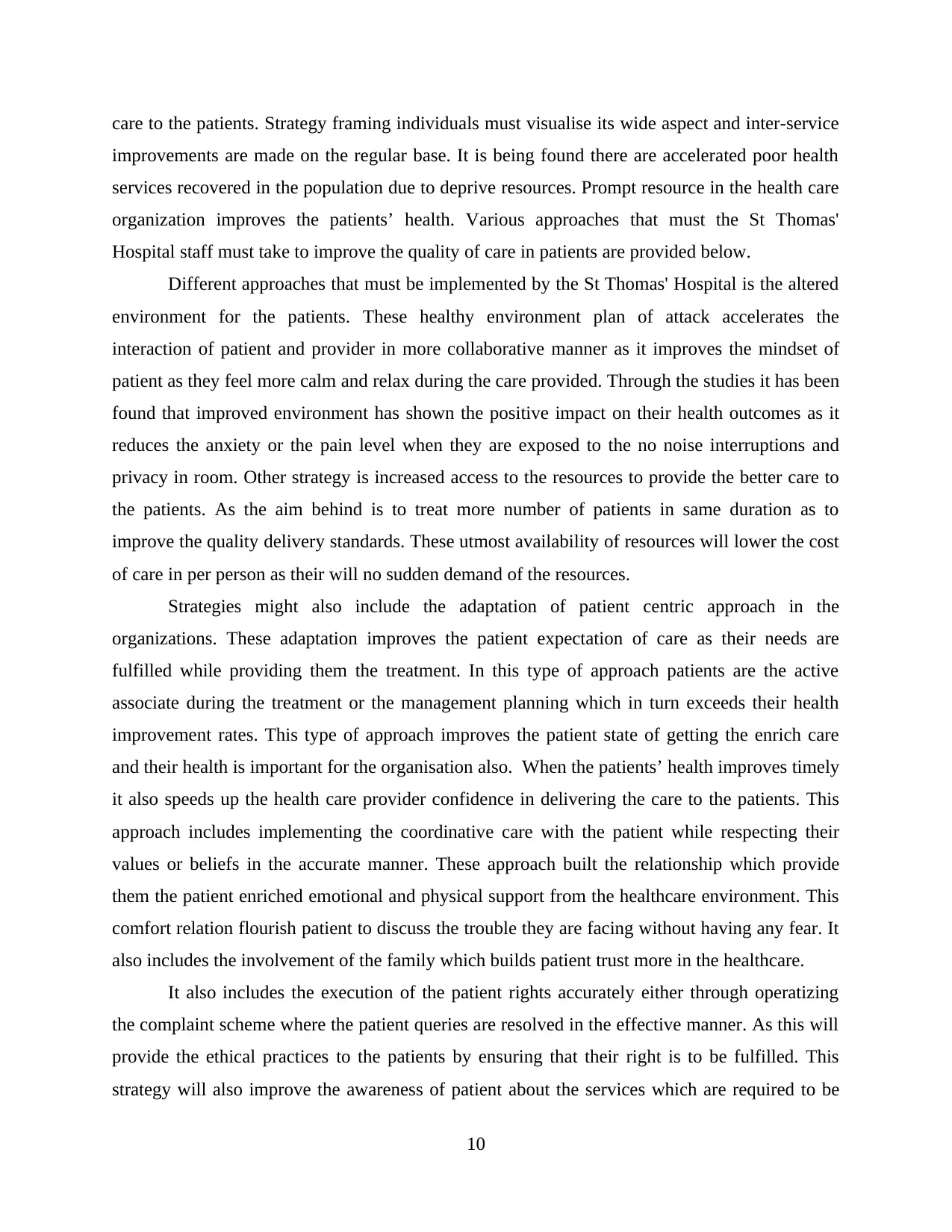
care to the patients. Strategy framing individuals must visualise its wide aspect and inter-service
improvements are made on the regular base. It is being found there are accelerated poor health
services recovered in the population due to deprive resources. Prompt resource in the health care
organization improves the patients’ health. Various approaches that must the St Thomas'
Hospital staff must take to improve the quality of care in patients are provided below.
Different approaches that must be implemented by the St Thomas' Hospital is the altered
environment for the patients. These healthy environment plan of attack accelerates the
interaction of patient and provider in more collaborative manner as it improves the mindset of
patient as they feel more calm and relax during the care provided. Through the studies it has been
found that improved environment has shown the positive impact on their health outcomes as it
reduces the anxiety or the pain level when they are exposed to the no noise interruptions and
privacy in room. Other strategy is increased access to the resources to provide the better care to
the patients. As the aim behind is to treat more number of patients in same duration as to
improve the quality delivery standards. These utmost availability of resources will lower the cost
of care in per person as their will no sudden demand of the resources.
Strategies might also include the adaptation of patient centric approach in the
organizations. These adaptation improves the patient expectation of care as their needs are
fulfilled while providing them the treatment. In this type of approach patients are the active
associate during the treatment or the management planning which in turn exceeds their health
improvement rates. This type of approach improves the patient state of getting the enrich care
and their health is important for the organisation also. When the patients’ health improves timely
it also speeds up the health care provider confidence in delivering the care to the patients. This
approach includes implementing the coordinative care with the patient while respecting their
values or beliefs in the accurate manner. These approach built the relationship which provide
them the patient enriched emotional and physical support from the healthcare environment. This
comfort relation flourish patient to discuss the trouble they are facing without having any fear. It
also includes the involvement of the family which builds patient trust more in the healthcare.
It also includes the execution of the patient rights accurately either through operatizing
the complaint scheme where the patient queries are resolved in the effective manner. As this will
provide the ethical practices to the patients by ensuring that their right is to be fulfilled. This
strategy will also improve the awareness of patient about the services which are required to be
10
improvements are made on the regular base. It is being found there are accelerated poor health
services recovered in the population due to deprive resources. Prompt resource in the health care
organization improves the patients’ health. Various approaches that must the St Thomas'
Hospital staff must take to improve the quality of care in patients are provided below.
Different approaches that must be implemented by the St Thomas' Hospital is the altered
environment for the patients. These healthy environment plan of attack accelerates the
interaction of patient and provider in more collaborative manner as it improves the mindset of
patient as they feel more calm and relax during the care provided. Through the studies it has been
found that improved environment has shown the positive impact on their health outcomes as it
reduces the anxiety or the pain level when they are exposed to the no noise interruptions and
privacy in room. Other strategy is increased access to the resources to provide the better care to
the patients. As the aim behind is to treat more number of patients in same duration as to
improve the quality delivery standards. These utmost availability of resources will lower the cost
of care in per person as their will no sudden demand of the resources.
Strategies might also include the adaptation of patient centric approach in the
organizations. These adaptation improves the patient expectation of care as their needs are
fulfilled while providing them the treatment. In this type of approach patients are the active
associate during the treatment or the management planning which in turn exceeds their health
improvement rates. This type of approach improves the patient state of getting the enrich care
and their health is important for the organisation also. When the patients’ health improves timely
it also speeds up the health care provider confidence in delivering the care to the patients. This
approach includes implementing the coordinative care with the patient while respecting their
values or beliefs in the accurate manner. These approach built the relationship which provide
them the patient enriched emotional and physical support from the healthcare environment. This
comfort relation flourish patient to discuss the trouble they are facing without having any fear. It
also includes the involvement of the family which builds patient trust more in the healthcare.
It also includes the execution of the patient rights accurately either through operatizing
the complaint scheme where the patient queries are resolved in the effective manner. As this will
provide the ethical practices to the patients by ensuring that their right is to be fulfilled. This
strategy will also improve the awareness of patient about the services which are required to be
10
Paraphrase This Document
Need a fresh take? Get an instant paraphrase of this document with our AI Paraphraser
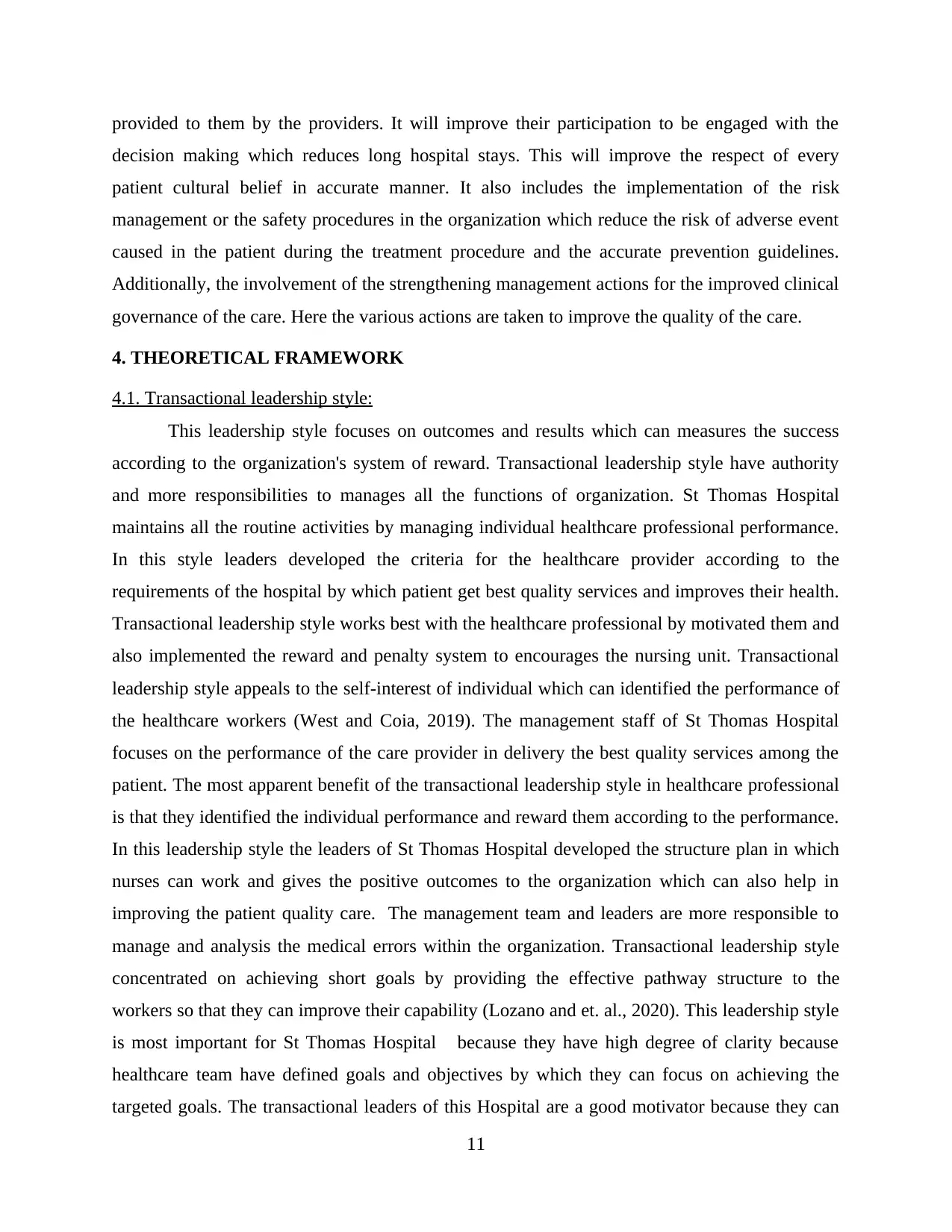
provided to them by the providers. It will improve their participation to be engaged with the
decision making which reduces long hospital stays. This will improve the respect of every
patient cultural belief in accurate manner. It also includes the implementation of the risk
management or the safety procedures in the organization which reduce the risk of adverse event
caused in the patient during the treatment procedure and the accurate prevention guidelines.
Additionally, the involvement of the strengthening management actions for the improved clinical
governance of the care. Here the various actions are taken to improve the quality of the care.
4. THEORETICAL FRAMEWORK
4.1. Transactional leadership style:
This leadership style focuses on outcomes and results which can measures the success
according to the organization's system of reward. Transactional leadership style have authority
and more responsibilities to manages all the functions of organization. St Thomas Hospital
maintains all the routine activities by managing individual healthcare professional performance.
In this style leaders developed the criteria for the healthcare provider according to the
requirements of the hospital by which patient get best quality services and improves their health.
Transactional leadership style works best with the healthcare professional by motivated them and
also implemented the reward and penalty system to encourages the nursing unit. Transactional
leadership style appeals to the self-interest of individual which can identified the performance of
the healthcare workers (West and Coia, 2019). The management staff of St Thomas Hospital
focuses on the performance of the care provider in delivery the best quality services among the
patient. The most apparent benefit of the transactional leadership style in healthcare professional
is that they identified the individual performance and reward them according to the performance.
In this leadership style the leaders of St Thomas Hospital developed the structure plan in which
nurses can work and gives the positive outcomes to the organization which can also help in
improving the patient quality care. The management team and leaders are more responsible to
manage and analysis the medical errors within the organization. Transactional leadership style
concentrated on achieving short goals by providing the effective pathway structure to the
workers so that they can improve their capability (Lozano and et. al., 2020). This leadership style
is most important for St Thomas Hospital because they have high degree of clarity because
healthcare team have defined goals and objectives by which they can focus on achieving the
targeted goals. The transactional leaders of this Hospital are a good motivator because they can
11
decision making which reduces long hospital stays. This will improve the respect of every
patient cultural belief in accurate manner. It also includes the implementation of the risk
management or the safety procedures in the organization which reduce the risk of adverse event
caused in the patient during the treatment procedure and the accurate prevention guidelines.
Additionally, the involvement of the strengthening management actions for the improved clinical
governance of the care. Here the various actions are taken to improve the quality of the care.
4. THEORETICAL FRAMEWORK
4.1. Transactional leadership style:
This leadership style focuses on outcomes and results which can measures the success
according to the organization's system of reward. Transactional leadership style have authority
and more responsibilities to manages all the functions of organization. St Thomas Hospital
maintains all the routine activities by managing individual healthcare professional performance.
In this style leaders developed the criteria for the healthcare provider according to the
requirements of the hospital by which patient get best quality services and improves their health.
Transactional leadership style works best with the healthcare professional by motivated them and
also implemented the reward and penalty system to encourages the nursing unit. Transactional
leadership style appeals to the self-interest of individual which can identified the performance of
the healthcare workers (West and Coia, 2019). The management staff of St Thomas Hospital
focuses on the performance of the care provider in delivery the best quality services among the
patient. The most apparent benefit of the transactional leadership style in healthcare professional
is that they identified the individual performance and reward them according to the performance.
In this leadership style the leaders of St Thomas Hospital developed the structure plan in which
nurses can work and gives the positive outcomes to the organization which can also help in
improving the patient quality care. The management team and leaders are more responsible to
manage and analysis the medical errors within the organization. Transactional leadership style
concentrated on achieving short goals by providing the effective pathway structure to the
workers so that they can improve their capability (Lozano and et. al., 2020). This leadership style
is most important for St Thomas Hospital because they have high degree of clarity because
healthcare team have defined goals and objectives by which they can focus on achieving the
targeted goals. The transactional leaders of this Hospital are a good motivator because they can
11
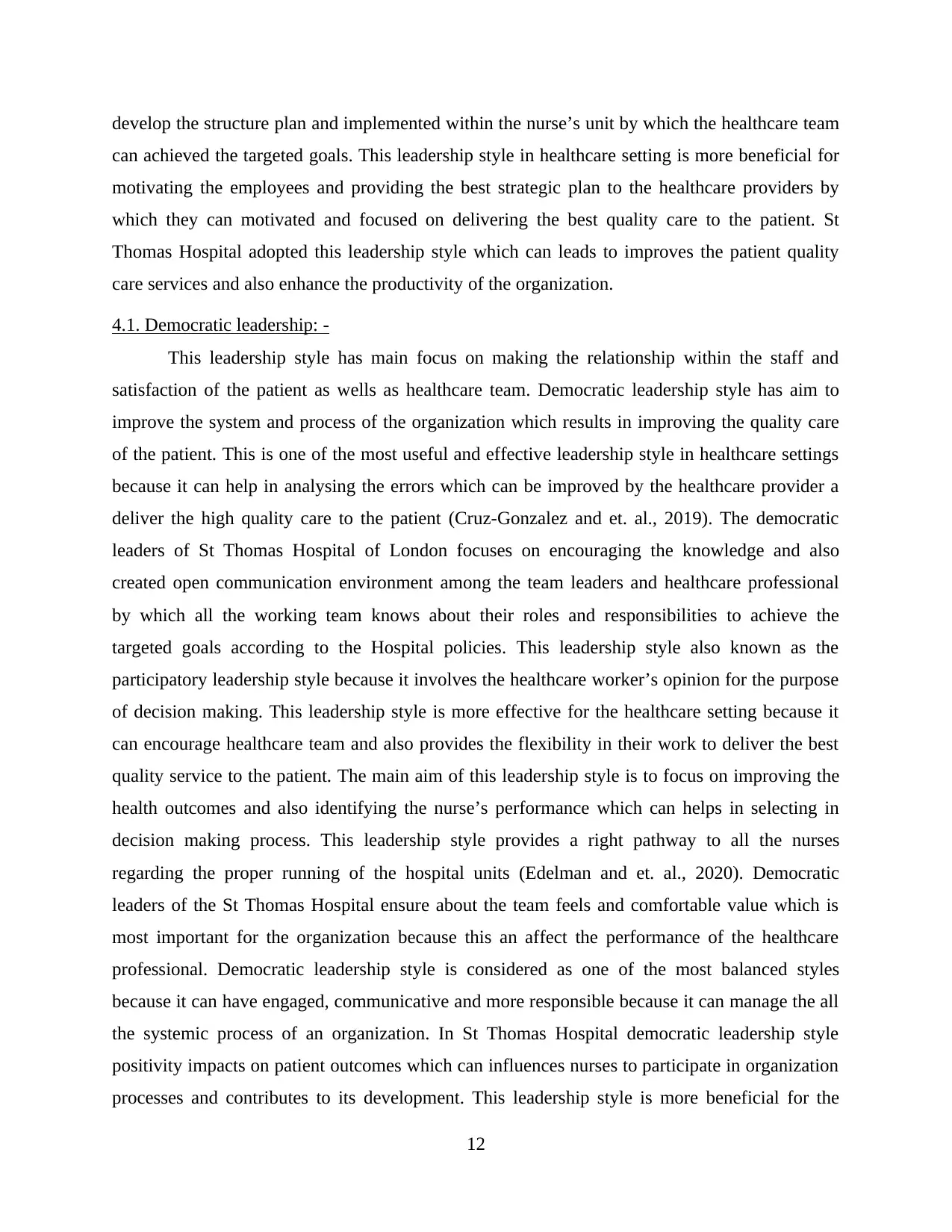
develop the structure plan and implemented within the nurse’s unit by which the healthcare team
can achieved the targeted goals. This leadership style in healthcare setting is more beneficial for
motivating the employees and providing the best strategic plan to the healthcare providers by
which they can motivated and focused on delivering the best quality care to the patient. St
Thomas Hospital adopted this leadership style which can leads to improves the patient quality
care services and also enhance the productivity of the organization.
4.1. Democratic leadership: -
This leadership style has main focus on making the relationship within the staff and
satisfaction of the patient as wells as healthcare team. Democratic leadership style has aim to
improve the system and process of the organization which results in improving the quality care
of the patient. This is one of the most useful and effective leadership style in healthcare settings
because it can help in analysing the errors which can be improved by the healthcare provider a
deliver the high quality care to the patient (Cruz-Gonzalez and et. al., 2019). The democratic
leaders of St Thomas Hospital of London focuses on encouraging the knowledge and also
created open communication environment among the team leaders and healthcare professional
by which all the working team knows about their roles and responsibilities to achieve the
targeted goals according to the Hospital policies. This leadership style also known as the
participatory leadership style because it involves the healthcare worker’s opinion for the purpose
of decision making. This leadership style is more effective for the healthcare setting because it
can encourage healthcare team and also provides the flexibility in their work to deliver the best
quality service to the patient. The main aim of this leadership style is to focus on improving the
health outcomes and also identifying the nurse’s performance which can helps in selecting in
decision making process. This leadership style provides a right pathway to all the nurses
regarding the proper running of the hospital units (Edelman and et. al., 2020). Democratic
leaders of the St Thomas Hospital ensure about the team feels and comfortable value which is
most important for the organization because this an affect the performance of the healthcare
professional. Democratic leadership style is considered as one of the most balanced styles
because it can have engaged, communicative and more responsible because it can manage the all
the systemic process of an organization. In St Thomas Hospital democratic leadership style
positivity impacts on patient outcomes which can influences nurses to participate in organization
processes and contributes to its development. This leadership style is more beneficial for the
12
can achieved the targeted goals. This leadership style in healthcare setting is more beneficial for
motivating the employees and providing the best strategic plan to the healthcare providers by
which they can motivated and focused on delivering the best quality care to the patient. St
Thomas Hospital adopted this leadership style which can leads to improves the patient quality
care services and also enhance the productivity of the organization.
4.1. Democratic leadership: -
This leadership style has main focus on making the relationship within the staff and
satisfaction of the patient as wells as healthcare team. Democratic leadership style has aim to
improve the system and process of the organization which results in improving the quality care
of the patient. This is one of the most useful and effective leadership style in healthcare settings
because it can help in analysing the errors which can be improved by the healthcare provider a
deliver the high quality care to the patient (Cruz-Gonzalez and et. al., 2019). The democratic
leaders of St Thomas Hospital of London focuses on encouraging the knowledge and also
created open communication environment among the team leaders and healthcare professional
by which all the working team knows about their roles and responsibilities to achieve the
targeted goals according to the Hospital policies. This leadership style also known as the
participatory leadership style because it involves the healthcare worker’s opinion for the purpose
of decision making. This leadership style is more effective for the healthcare setting because it
can encourage healthcare team and also provides the flexibility in their work to deliver the best
quality service to the patient. The main aim of this leadership style is to focus on improving the
health outcomes and also identifying the nurse’s performance which can helps in selecting in
decision making process. This leadership style provides a right pathway to all the nurses
regarding the proper running of the hospital units (Edelman and et. al., 2020). Democratic
leaders of the St Thomas Hospital ensure about the team feels and comfortable value which is
most important for the organization because this an affect the performance of the healthcare
professional. Democratic leadership style is considered as one of the most balanced styles
because it can have engaged, communicative and more responsible because it can manage the all
the systemic process of an organization. In St Thomas Hospital democratic leadership style
positivity impacts on patient outcomes which can influences nurses to participate in organization
processes and contributes to its development. This leadership style is more beneficial for the
12
⊘ This is a preview!⊘
Do you want full access?
Subscribe today to unlock all pages.

Trusted by 1+ million students worldwide
1 out of 21
Related Documents
Your All-in-One AI-Powered Toolkit for Academic Success.
+13062052269
info@desklib.com
Available 24*7 on WhatsApp / Email
![[object Object]](/_next/static/media/star-bottom.7253800d.svg)
Unlock your academic potential
Copyright © 2020–2025 A2Z Services. All Rights Reserved. Developed and managed by ZUCOL.





